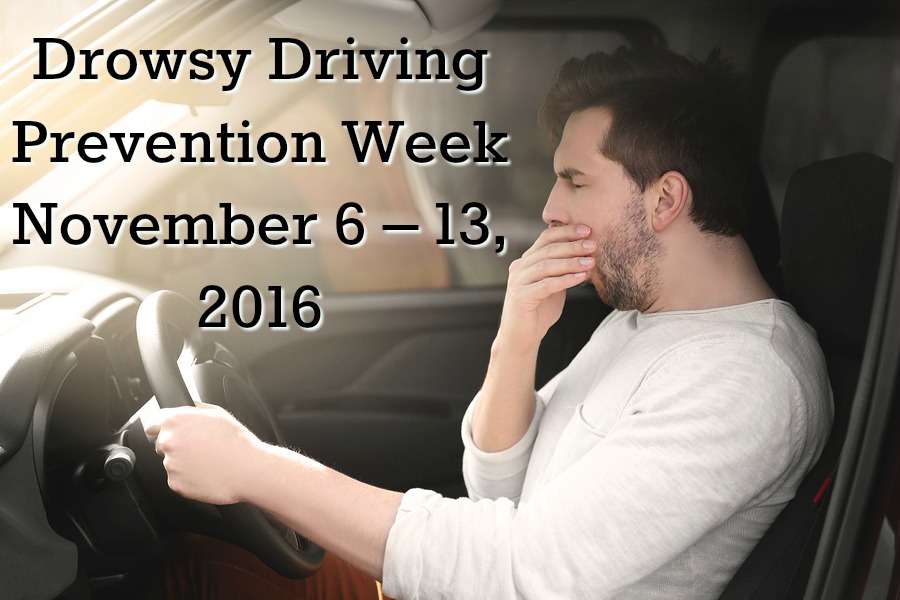In an effort to save lives and reduce crashes, the National Sleep Foundation has declared November 6 – 13, 2016 Drowsy Driving Prevention Week®.

The National Sleep Foundation states that more than half of American adult drivers have admitted to driving drowsy, and almost one in five admit to having fallen asleep behind the wheel. The 2014 National Highway Traffic Safety Administration (NHTSA) documented 416,000 crashes resulting from drowsy driving between 2005 and 2009. These accidents resulted in over 184,000 injuries and 5,000 fatalities.
According to NHTSA’s National Motor Vehicle Crash Causation Study (NMVCCS), drowsy drivers involved in a crash are twice as likely to make performance errors as compared to drivers who are not tired. When a person drives while tired their reaction time, judgment, alertness, attention, and decision-making are all compromised which leads to a greater chance of crashing. In some cases, a drowsy driver will fall asleep at the wheel.
Drowsy Driving Statistics
- 36 percent of Americans have fallen asleep while driving, per the 2008 Sleep in America Poll.
- 60 percent of Americans said they’ve driven while feeling drowsy, per the 2005 Sleep in American Poll.
- The NHTSA estimates 2.5 percent of deadly crashes and 2 percent of injury crashes involve drowsy driving. * This is thought to be an underestimation.
- Cognitive impairment after being awake about 18 hours is similar to someone with a blood alcohol content of 0.05 percent.
- Cognitive impairment after 24 hours awake is equivalent to a blood alcohol content of 0.10 percent, higher than the legal limit.
- Though driving drowsy can cause crashes both day and night, they occur most frequently between midnight and 6 a.m., or in the late afternoon- both of which are times when there are dips in the circadian rhythm.
- Many drowsy-driving crashes involve only a single vehicle, with no passengers besides the driver running off the road at a high rate of speed with no evidence of braking.
- Drowsy-driving crashes frequently occur on rural roads and highways.
Who’s at risk?
The National Sleep Foundation’s DrivingDrowsy.org webpage states that although anyone who drives is at risk of falling asleep at the wheel, some groups of people are more at risk than others:
- Business travelers– Frequent travelers who may be suffering from jet lag and crossing time zones, spending long hours behind the wheel or getting too little sleep.
- Commercial drivers– Those who drive a high number of miles and drive at night are at significantly higher risk for fall-asleep crashes. Commercial drivers have also been found to be at a high risk for sleep disorders.
- People with untreated sleep disorders such as obstructive sleep apnea (OSA)– People with untreated OSA are up to seven times more likely to have a drowsy driving crash. For some people, insomnia can increase fatigue.
- Shift workers and people working long hours– People who work rotating shifts, double shifts, night shifts or work more than one job have a six-fold increase in drowsy driving crashes.
- Young drivers– Combining inexperience with sleepiness and a tendency to drive at night puts young people at risk, especially males aged 16-25 years.
Though some are more vulnerable to falling asleep and crashing while driving, everyone has the potential to cause a fatigue related accident. Your risks increase when you are:
- Driving long distances without proper rest breaks
- Working 60 hours or more a week
- Sleep deprived and/or fatigued
- Drinking alcohol
- Driving alone, especially on long, dark, rural, or boring roads
- Taking medications such as antihistamines, cold tablets, or antidepressants
- Experiencing jet lag
Common signs that you are too drowsy to drive include:
- Yawning, rubbing your eyes, frequent blinking
- Having trouble keeping your eyes open or your head up
- Difficulty remembering the past few miles driven
- Drifting from your lane or off the road
- Slower reaction time
- Daydreaming and wandering thoughts
- Feeling restless, irritable or aggressive
*If you notice that you are feeling any of the above signs of fatigue, stop driving– pull off at the nearest exit or rest area, or find a place to sleep for the night.
Drowsy Driving Prevention Tips
- Get a good night’s sleep
- Plan long trips with a companion
- Schedule regular stops
- Try to avoid driving at times you would normally be sleeping
- Avoid alcohol and medications that may make you tired
- Consume caffeine – the equivalent of 2 cups of coffee can increase alertness for several hours, but DO NOT rely on it for long periods
- If you feel tired, pull over and take a 15-20-minute nap
- Try consuming caffeine before taking a short nap to get the benefits of both
The best way for you to avoid a fatigue related car accident is to get a good night’s rest on a regular basis, practice good sleep hygiene, and to seek treatment if you are having problems sleeping at night or are not feeling rested during the day.

